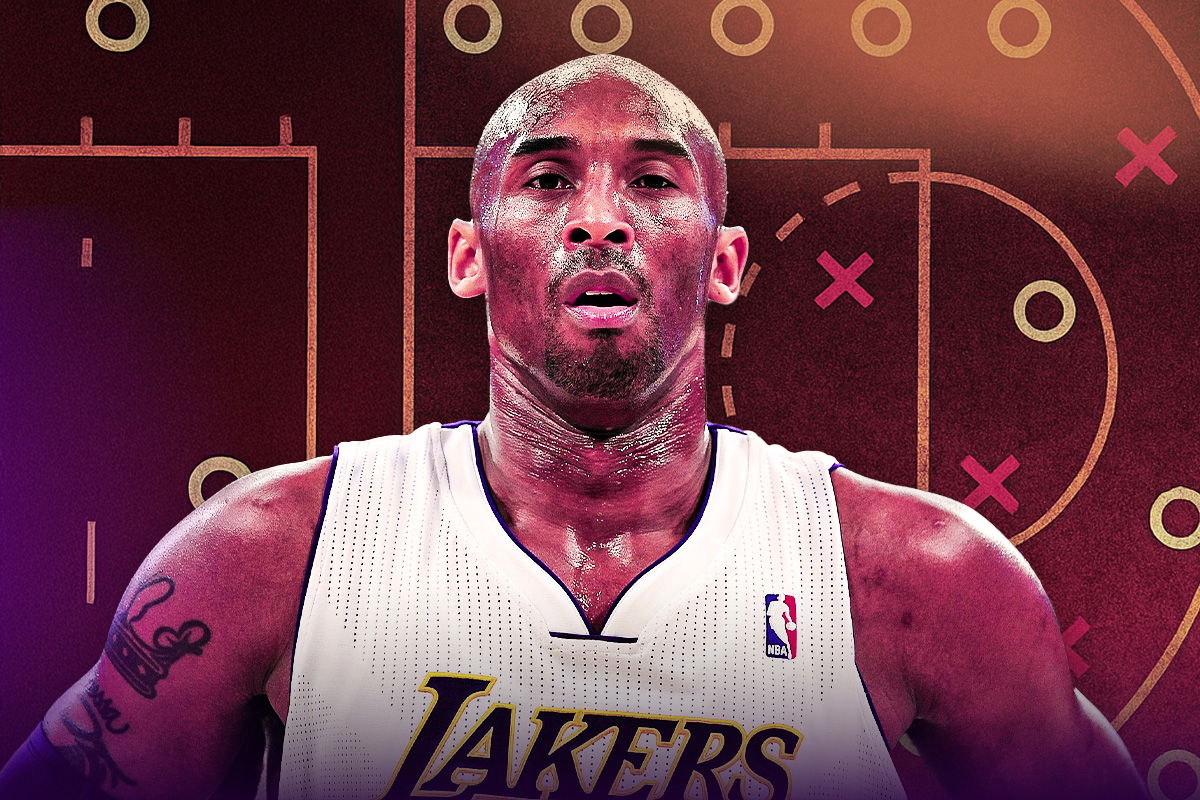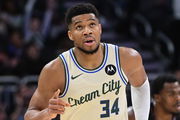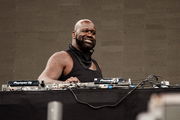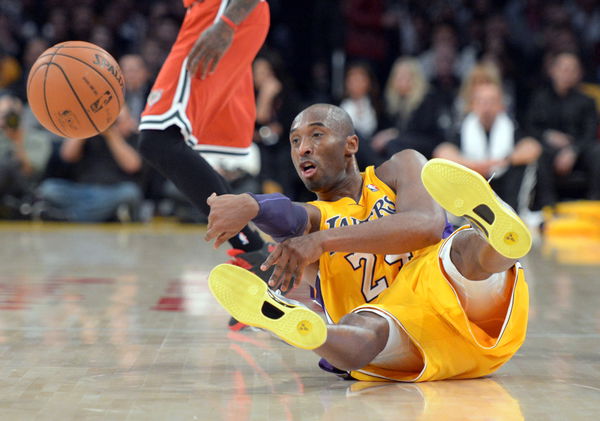
Imago
January 13, 2013; Los Angeles, CA, USA; Los Angeles Lakers shooting guard Kobe Bryant (24) during a stoppage in play against the Cleveland Cavaliers during the first half at Staples Center. Mandatory Credit: Gary A. Vasquez-Imagn Images

Imago
January 13, 2013; Los Angeles, CA, USA; Los Angeles Lakers shooting guard Kobe Bryant (24) during a stoppage in play against the Cleveland Cavaliers during the first half at Staples Center. Mandatory Credit: Gary A. Vasquez-Imagn Images
You grow up a Lakers fan, you don’t pick a favorite player, you rather inherit one. You remember where you were. When he dropped 81. When he tore his Achilles tendon, and still walked to the line. The time he made you believe that loyalty still meant something in this league. For a generation of fans, Kobe Bryant was the heart and soul of the Lakers. So, when a list ranks the greatest to ever enter the NBA league? Your heart doesn’t wander. It automatically makes you think you’d see his name at the top. That’s the first betrayal.
Watch What’s Trending Now!
Somewhere in a sterile analytics lab or an algorithm-obsessed corner of the internet, Kobe Bryant has been ranked outside the top 10 NBA players of all time. Not fifth, sixth, heck, not even eighth. But eleventh. That sound you hear? It’s Lakers fans choking in disbelief. It’s grown men in No. 8 and No. 24 jerseys pacing their living rooms. And it is an entire generation asking: “Have y’all lost your minds?” Because, people, as you know it already, this isn’t about nostalgia.
It’s about nuance. It’s about how modern metrics have rewritten basketball history, and in doing so, somehow tried to pixelate out one of the sport’s most relentless icons. Because if your spreadsheet says Kobe wasn’t one of the top 10 greatest to ever touch a basketball, maybe the spreadsheet needs therapy, for real. But let’s talk about the crime scene, shall we?
ADVERTISEMENT
Effective field goal percentage (eFG%). It adjusts for the fact that threes are worth more than twos. Sounds logical, until it’s used like a sledgehammer on a player who spent the early 2000s navigating a league built like a mosh pit. Kobe had just four seasons with an eFG% above 50% and never topped 51%. That stat has been plastered across social media like it’s the last word. But here’s the thing: efficiency in 2002 didn’t look like efficiency in 2025.
In Kobe Bryant’s prime, teams were still trotting out two non-shooting bigs and daring defenses to collapse the paint. There were no five-out offenses, no gravitational shooters spacing the floor from 35 feet. You want to talk about tough shot-making? Kobe had no choice. The man operated in a basketball world that was stacked against perimeter scorers. Yet he still thrived. Still won and dragged his team to relevance when the roster around him looked like a G League warmup act. Want proof Kobe wasn’t inefficient by nature? Look at 2013.
ADVERTISEMENT
A glimpse into the modern era: Kobe’s 2013 season
At 34 years old, on shredded knees and heading straight toward that infamous Achilles tear, Kobe posted his most efficient scoring season ever. He averaged 27.3 points on a .551 true shooting percentage while playing a league-high 38.6 minutes per game. That was the year Mike D’Antoni’s system gave him the spacing he’d never had. The result? A masterclass in controlled aggression, tempo, and IQ.
The evolution of the NBA offense had finally caught up with Kobe’s mind. And he weaponized it immediately. Even without peak athleticism, his footwork, angles, and decision-making shredded modern defenses. Which, well, makes you wonder: what would 2006 Kobe have looked like with the floor spacing of 2025? With today’s freedom-of-movement rules? With a roster where defenses couldn’t hide three players in the paint every possession? It’s not just hypothetical.
ADVERTISEMENT
You saw flashes of it in real time… a slower, wiser Kobe carving up elite defenses like he had the cheat code. He didn’t need to jump over you anymore. He just walked you into your mistake, every possession, like it was scripted. Give that version of Kobe today’s pace, today’s space, and today’s whistle? You’re not talking about just survival in the modern game. You’re talking domination. Which raises the real question: how does a player like that stack up against the supposed kings of his era?
Top Stories
Shaquille O’Neal’s Lakers Teammate Arrested Again As Arizona Court Issues Verdict On Order Violation

Did Zion Williamson Slide Into Sydney Sweeney’s DMs? Fact Checking the Viral Screenshot

Anthony Edwards Breaks Silence On Wolves HC Chris Finch Ejection After Win vs OKC

Bucks Eyeing $97M NBA Guard To Help Giannis Antetokounmpo, As Per Reports

Shaquille O’Neal Drops Verdict On Jake Paul vs Anthony Joshua After Round 6 KO

How Kobe stacked up against his peers
If you really want to play the metrics game, fine. Let’s do it properly. We’re talking about the Mamba, after all.
ADVERTISEMENT
- Allen Iverson: Never posted an eFG% above 49% in his entire career.
- Tracy McGrady: Surpassed 50% eFG just once, barely at 50.5%.
- Vince Carter: Had just two 20+ PPG seasons with an eFG% over 50%. Never crossed 51%.
- Grant Hill: Two seasons over 50% eFG while averaging 20+.
Kobe wasn’t just within range. He was the range, and that’s not an exaggeration. In fact, he surpassed most of his contemporaries while carrying heavier offensive burdens, playing in more playoff games, and defending at an elite level.

USA Today via Reuters
Jan 15, 2013, Los Angeles, CA, USA; Los Angeles Lakers guard Kobe Bryant (24) passes the ball against the Milwaukee Bucks at the Staples Center. The Lakers defeated the Bucks 104-88. Mandatory Credit: Kirby Lee/USA TODAY Sports
The analytics crowd isolates his numbers but forgets the human conditions under which they were produced. Basketball isn’t a clean lab experiment. It’s physical, emotional, and contextual. And no one understood that better than Kobe. But if the regular season is the test, the playoffs are the trial by fire. And Kobe turned the heat up, rightly so.
ADVERTISEMENT
Postseason Proof: Even the best of the NBA couldn’t tame Kobe
- Faced 25 playoff opponents with 50+ wins. His Lakers went 20-5 in those series (.800 win rate). That’s the best such record of any player with 20+ series.
- In the 2001 playoffs, Kobe averaged 29.4 PPG on 49% shooting against three 50-win teams.
- He led the entire playoffs in Win Shares at age 22.
- His career playoff series record? 33-10 (.767). That’s better than Jordan (.755) and LeBron (.727).
ADVERTISEMENT
These aren’t footnotes. They’re exclamation marks. While modern stars benefit from heliocentric systems and rules designed for offense, Kobe was doing this in a league that made you earn every inch. Every bucket was a battle. Every series was a war zone. And well, it’s fair to get lost and confused in translation, but even if you ignore advanced stats altogether, the sheer weight of Kobe’s achievements crushes the argument’s entirety:
| Category | Total | All-Time Rank | Notes |
| Regular-season points | 33,643 | 4th | Only guard in the top 4 |
| Playoff points | 5,640 | 4th | Trails only LeBron, Jordan, and Kareem |
| 40-point games | 135 | 3rd | Behind Wilt & Jordan |
| 50-point games | 26 | 3rd | More than Curry, Bird, and Duncan combined |
| 60-point games | 6 | 2nd | Second only to Wilt |
| All-Defensive Selections | 12 (9 First Team) | 1st among guards | Tied 2nd overall |
| All-NBA Selections | 15 | T-1st | With LeBron, Kareem, and Duncan |
| Championships | 5 | T-14th | Most by a post-1990 perimeter player |
| Playoff Series Record | 33-10 (.767) | Best ever for any 20-year vet |
In a resume stuffed with dominance, perhaps the most telling figure is this: 135 games scoring 40 or more. That’s 135 nights where teams knew what was coming, threw everything at him, and still couldn’t stop it. Now that’s not inefficiency. That, my friends, is inevitability. The biggest flaw with modern metrics is that they try to flatten basketball into a spreadsheet.
ADVERTISEMENT
Why modern NBA metrics get it so wrong
They remove context, emotion, difficulty, and most critically, environment. Kobe played in one of the toughest scoring eras in league history. Early 2000s defenses were not just allowed to be physical, but they were also encouraged to be.
You had hand-checking, zone defenses, low spacing, and limited pace. The paint looked like Times Square on New Year’s Eve. There was no “illegal defense” excuse like in the ’90s, but also no modern “free movement” rules either. Every shot was contested, every lane collapsed, and every possession was a war. So, when we apply the 2025 formulas to the 2004 basketball? We’re not measuring greatness. We’re distorting it. You want to know how great Kobe was? Just look at today’s stars.
ADVERTISEMENT
Devin Booker borrowed his footwork. Jayson Tatum idolized his mentality. Kyrie Irving credits his midrange game to Mamba tutorials. Kevin Durant once said of him, “He’s the greatest of all time. His skill is second to none. Him and MJ are neck and neck as far as skill… Kobe is the top two best ever in just having skill, footwork, shooting the 3, shooting the pull-up, posting up, dunking on guys and ball handling. Kobe and Jordan are 1 and 1A.” And LeBron?
LeBron wanted him on Team USA not just for buckets, but to teach how to win. Kobe wasn’t chasing a mold. He made the mold. And still, he strengthened when the game did. That’s why the 2013 season mattered. It showed us that Kobe could have dropped into any era and still carved defenses up like Thanksgiving turkey. And well, when AI-generated rankings or cold-blooded stat bots leave you questioning and agreeing with the traditional NBA, it does more than slight his legacy.
It disrespects an era, erases nuance, and forgets that greatness doesn’t always come gift-wrapped in neat little percentages. Kobe Bryant played to win and dominate. To set an example. And whether you measure it by championships, performances, mentality, or respect among peers, he belongs among the top five players to ever do it. Because this isn’t just about what Kobe did. It’s about how he did it, right?
In the league’s most bruising years, he scored with elegance. In the sport’s most dramatic moments, he thrived. And in the era before pace and space, he danced in chaos and turned it into poetry. But when the lights were brightest, oh man, did he scorch! So, the next time you see a stat that says otherwise, ask it this: Did it see Kobe drop 60 in his final game? Did it feel the weight of five titles? Did it watch No. 8 become No. 24 and still remain him? Because if your metric doesn’t understand Kobe Bryant, it doesn’t understand basketball at all, period.
ADVERTISEMENT
ADVERTISEMENT
ADVERTISEMENT

